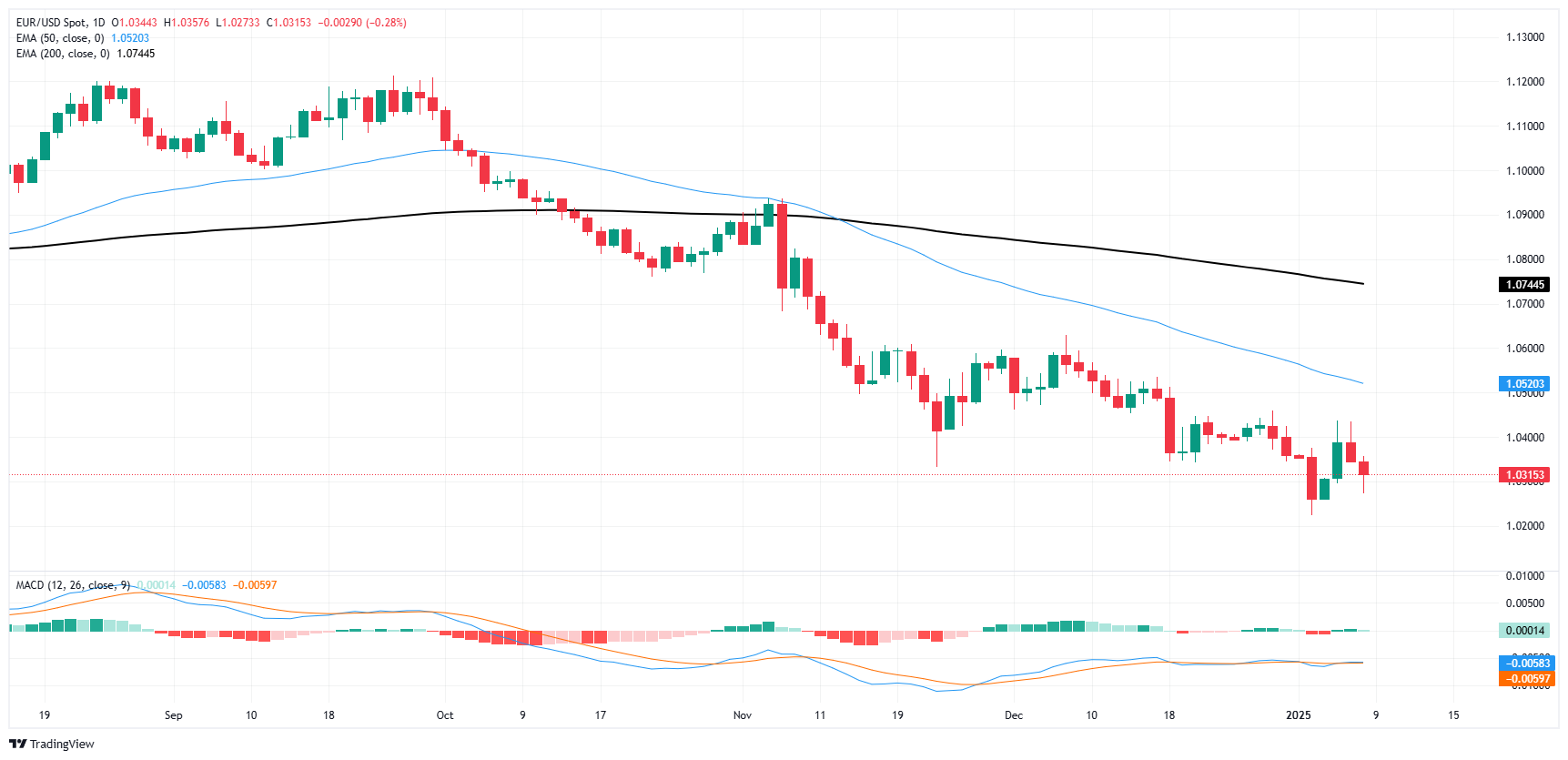EUR/USD stuck near 1.03 ahead of Retail Sales update
- EUR/USD shed 0.25% and fell back into the 1.0300 handle on Wednesday.
- Despite the midweek downside push, Fiber is holding above two year lows for now.
- EU Retail Sales, German Industrial Production, and US Challenger Job Cuts on the docket.
EUR/USD fell back once again on Wednesday, dipping back into the 1.0300 handle as Fiber traders weigh mixed EU data while sitting in the shadow of Friday’s looming US Nonfarm Payrolls (NFP) jobs data dump.
European data broadly recovered early Wednesday, with German Retail Sales and pan-European Producer Price Index (PPI) figures both rising from previous prints, but most data printed with below-average caveats, especially EU PPI inflation which remains in contraction territory. Euro traders will be hoping for an upside swing in pan-EU Retail Sales figures for the year ended in December, due early Thursday, but not until after German Industrial Production figures kick off the European trading session.
A raft of speeches from Federal Reserve (Fed) policymakers await traders on Thursday, as well as Challenger Job Cuts for December, which will serve as the last punch of NFP preview data before the bumper labor print on Friday.
ADP Employment Change in December showed slower hiring at 122K compared to 140K expected and 146K in November. Wage data is at its slowest since mid-2021.
The Federal Reserve's latest Meeting Minutes indicated greater concern over President Trump's tariff plans than initially thought. Despite earlier reassurances from Fed speakers about immigration and trade policies' minimal impact, the minutes highlighted four discussion points on major US policy changes affecting central banking. Additionally, the Fed agreed it was time to slow rate cuts, stressing that policy uncertainty is driving expectations for fewer cuts in 2025 than previously anticipated.
EUR/USD price forecast
EUR/USD near-term battle with the 1.0300 handle leaves Fiber traders pushed firmly onto the backfoot as bidders struggle to keep price action north of multi-year lows. The pair has slumped consistently since kicking off a bearish trend near the end of September. EUR/USD fell 8.82% top-to-bottom, knocking into 26-month lows in the process.
A bullish turnaround is on the cards with bids testing into arguably oversold territory, but Euro bulls will need to first contend with the 50-day Exponential Moving Average (EMA), which is grinding down into the 1.0500 handle.
EUR/USD daily chart
Euro FAQs
The Euro is the currency for the 19 European Union countries that belong to the Eurozone. It is the second most heavily traded currency in the world behind the US Dollar. In 2022, it accounted for 31% of all foreign exchange transactions, with an average daily turnover of over $2.2 trillion a day. EUR/USD is the most heavily traded currency pair in the world, accounting for an estimated 30% off all transactions, followed by EUR/JPY (4%), EUR/GBP (3%) and EUR/AUD (2%).
The European Central Bank (ECB) in Frankfurt, Germany, is the reserve bank for the Eurozone. The ECB sets interest rates and manages monetary policy. The ECB’s primary mandate is to maintain price stability, which means either controlling inflation or stimulating growth. Its primary tool is the raising or lowering of interest rates. Relatively high interest rates – or the expectation of higher rates – will usually benefit the Euro and vice versa. The ECB Governing Council makes monetary policy decisions at meetings held eight times a year. Decisions are made by heads of the Eurozone national banks and six permanent members, including the President of the ECB, Christine Lagarde.
Eurozone inflation data, measured by the Harmonized Index of Consumer Prices (HICP), is an important econometric for the Euro. If inflation rises more than expected, especially if above the ECB’s 2% target, it obliges the ECB to raise interest rates to bring it back under control. Relatively high interest rates compared to its counterparts will usually benefit the Euro, as it makes the region more attractive as a place for global investors to park their money.
Data releases gauge the health of the economy and can impact on the Euro. Indicators such as GDP, Manufacturing and Services PMIs, employment, and consumer sentiment surveys can all influence the direction of the single currency. A strong economy is good for the Euro. Not only does it attract more foreign investment but it may encourage the ECB to put up interest rates, which will directly strengthen the Euro. Otherwise, if economic data is weak, the Euro is likely to fall. Economic data for the four largest economies in the euro area (Germany, France, Italy and Spain) are especially significant, as they account for 75% of the Eurozone’s economy.
Another significant data release for the Euro is the Trade Balance. This indicator measures the difference between what a country earns from its exports and what it spends on imports over a given period. If a country produces highly sought after exports then its currency will gain in value purely from the extra demand created from foreign buyers seeking to purchase these goods. Therefore, a positive net Trade Balance strengthens a currency and vice versa for a negative balance.
